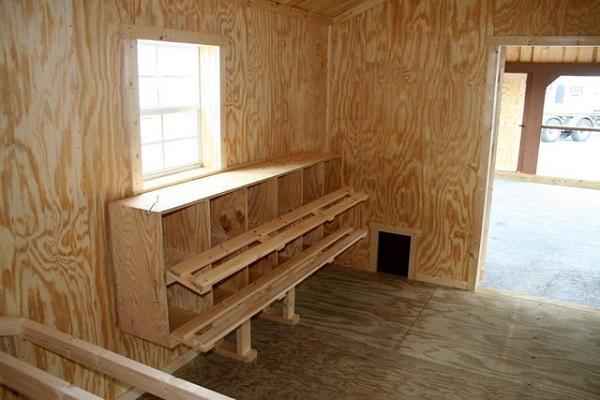Poultry: how to equip a chicken coop at home, practical advice
 Poultry farming is simply impossible without a “bird house”, because in winter the bird, including chickens, needs warmth and is not able to survive in the open air. If a solid barn is available on the site, it may well serve as a dwelling for chickens. Otherwise, the chicken coop will have to be built from scratch. Do not be afraid - this is not at all difficult to do if you follow the advice of experienced poultry farmers.
Poultry farming is simply impossible without a “bird house”, because in winter the bird, including chickens, needs warmth and is not able to survive in the open air. If a solid barn is available on the site, it may well serve as a dwelling for chickens. Otherwise, the chicken coop will have to be built from scratch. Do not be afraid - this is not at all difficult to do if you follow the advice of experienced poultry farmers.
So, when arranging chicken coop you need to pay attention to the following points:
- material for walls;
- the size of the chicken coop;
- lighting;
- ventilation;
- walking manhole;
- roosts;
- nests.
What is the best way to make the walls of the chicken coop?
First of all, you need to decide on the material. Both brick and foam block are suitable for the construction of the walls of the hen house, however, a wooden shed will be the best option for poultry farming, especially in the summer. The advantage of a wooden chicken coop is the relatively low cost of materials compared to a stone one. In addition, the microclimate in such a dwelling is an order of magnitude better, since the tree has the ability to breathe.
Wooden walls must be whitewashed annually with a solution of lime to prevent the appearance of poultry pests.
For year-round keeping of chickens, the hen house must be insulated. In winter, the minimum room temperature should not fall below 10 degrees Celsius. The rest of the time, 15 degrees is considered a comfortable temperature. If the temperature drops, the chickens will stop laying eggs, moreover, even frostbite of the paws is possible.
What should be the size of the chicken coop?
The area of the chicken coop directly depends on the number of bird heads. For 1 sq. m, no more than 5 layers or a dozen young hens are allowed.
The minimum area for 5 chickens cannot be less than 3 square meters. m.
As for the floors, it is not recommended to use earthen and clay floors in poultry farming, they are easily damaged by rodents. One of the most practical flooring options is a fine mesh cement screed. The screed must be covered with bedding, such as sawdust.
Coop lighting
In the room for keeping chickens, it is imperative to provide window openings from the southwest side. The size of the window is approximately ¼ of the floor area. When growing poultry in regions with severe winters, it is necessary to make an additional, winter, window frame (removable).
Additionally, electric lighting must be installed in the chicken coop, while it is better to hang the lamp with a shade. It is necessary to position the light bulb so that the main lighting is in the area of the feeders and perches. In a semi-dark room, chickens will sleep most of the time, while their egg production will decrease.
Ventilation and walkway
In the chicken room, especially in the insulated chicken coop, it is imperative to provide for an inflow of fresh air. To do this, you can install an exhaust fan (in small rooms) or make a simple supply and exhaust ventilation.
In order for the chickens to move freely outside the hen house, at a short distance from the floor, it is necessary to make them a small manhole, a size of 30x30 cm is sufficient. Of course, if the territory of the farm yard allows walking birds. It must be closed with a door that can be used as a bridge.
Perches for chickens
Perches are an obligatory element of the hen house.Chickens should not sleep on the floor or in nests. For perches, it is good to use 5x6 cm wooden blocks with rounded ends so that the chickens do not injure their paws. They should be installed at a height of 50 cm from the floor. The distance between the bars should be at least 35 cm for the bird to sit freely, and 25 cm from the last bar to the wall. One chicken per roost requires 25 cm perches.
Removing the perch bars makes them easier to clean and handle.
Some poultry breeders practice ladder perches, but in this case the chickens pollute each other. It is better to place the poles vertically.
Nests
Place for nests for chickens must be set aside in the darkest corner of the hen house. The nest should go 40 cm deep in order to layer fit in it. The nests must be installed on a hill (40 cm from the floor). For a dozen layers, 3-4 nests are enough.
Chickens of different ages must be kept separately, otherwise an adult bird can offend pullets. In addition, the brood and hen should also be separated. As for the presence of a rooster, then its presence is not at all necessary if it is planned to keep chickens only for obtaining eggs. But for breeding domestic chickens, you cannot do without it.